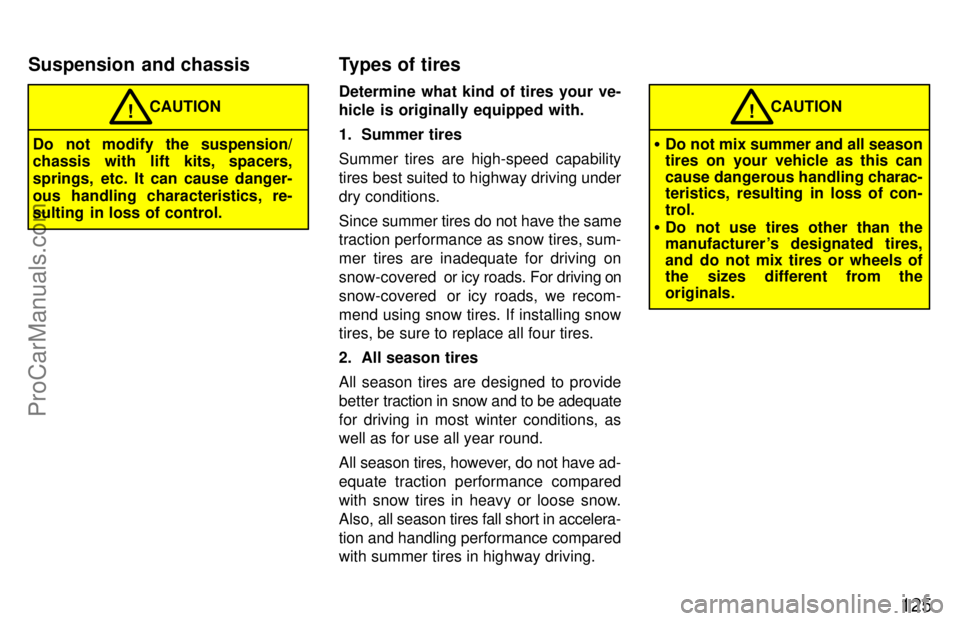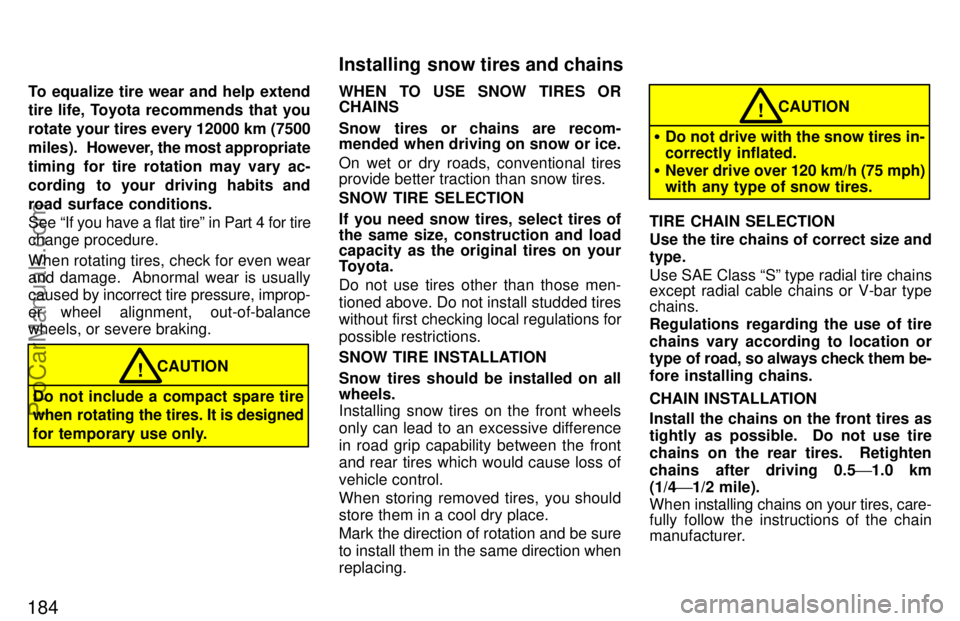Page 131 of 218

125
CAUTION!
Do not modify the suspension/
chassis with lift kits, spacers,
springs, etc. It can cause danger-
ous handling characteristics, re-
sulting in loss of control.Determine what kind of tires your ve-
hicle is originally equipped with.
1. Summer tires
Summer tires are high-speed capability
tires best suited to highway driving under
dry conditions.
Since
summer tires do not have the same
traction performance as snow tires, sum-
mer tires are inadequate for driving on
snow-covered or icy roads. For driving on
snow-covered or icy roads, we recom-
mend using snow tires. If installing snow
tires, be sure to replace all four tires.
2. All season tires
All season tires are designed to provide
better traction in snow and to be adequate
for driving in most winter conditions, as
well as for use all year round.
All season tires, however, do not have ad-
equate traction performance compared
with snow tires in heavy or loose snow.
Also, all season tires fall short in accelera-
tion and handling performance compared
with summer tires in highway driving.
CAUTION!
� Do not mix summer and all season
tires on your vehicle as this can
cause dangerous handling charac-
teristics, resulting in loss of con-
trol.
� Do not use tires other than the
manufacturer 's designated tires,
and do not mix tires or wheels of
the sizes different from the
originals.
Suspension and chassis Types of tires
ProCarManuals.com
Page 190 of 218

184
To equalize tire wear and help extend
tire life, Toyota recommends that you
rotate your tires every 12000 km (7500
miles). However, the most appropriate
timing for tire rotation may vary ac-
cording to your driving habits and
road surface conditions.
See If you have a flat tireº in Part 4 for tire
change procedure.
When rotating tires, check for even wear
and damage. Abnormal wear is usually
caused by incorrect tire pressure, improp-
er wheel alignment, out-of-balance
wheels, or severe braking.
CAUTION
Do not include a compact spare tire
when rotating the tires. It is designed
for temporary use only.!
WHEN TO USE SNOW TIRES OR
CHAINS
Snow tires or chains are recom-
mended when driving on snow or ice.
On wet or dry roads, conventional tires
provide better traction than snow tires.
SNOW TIRE SELECTION
If you need snow tires, select tires of
the same size, construction and load
capacity as the original tires on your
Toyota.
Do not use tires other than those men-
tioned above. Do not install studded tires
without first checking local regulations for
possible restrictions.
SNOW TIRE INSTALLATION
Snow tires should be installed on all
wheels.
Installing snow tires on the front wheels
only can lead to an excessive difference
in road grip capability between the front
and rear tires which would cause loss of
vehicle control.
When storing removed tires, you should
store them in a cool dry place.
Mark the direction of rotation and be sure
to install them in the same direction when
replacing.CAUTION
� Do not drive with the snow tires in-
correctly inflated.
� Never drive over 120 km/h (75 mph)
with any type of snow tires.!
TIRE CHAIN SELECTION
Use the tire chains of correct size and
type.
Use SAE Class Sº type radial tire chains
except radial cable chains or V-bar type
chains.
Regulations regarding the use of tire
chains vary according to location or
type of r oad, so always check them be-
fore installing chains.
CHAIN INSTALLATION
Install the chains on the front tires as
tightly as possible. Do not use tire
chains on the rear tires. Retighten
chains after driving 0.5 '1.0 km
(1/4 '1/2 mile).
When installing chains on your tires, care-
fully follow the instructions of the chain
manufacturer.
Installing snow tires and chains
ProCarManuals.com
Page 218 of 218

212
This information has been prepared in ac-
cordance with regulations issued by the
National Highway Traffic Safety Adminis-
tration of the U.S. Department of Trans-
portation. It provides the purchasers and/
or prospective purchasers of Toyota
vehicles with information on uniform tire
quality grading.
Your Toyota dealer will help answer any
questions you may have as you read this
information.
DOT quality gradesÐAll passenger
vehicle tires must conform to Federal
Safety Requirements in addition to
these grades. These quality grades are
molded on the sidewall.
Treadwear ÐThe treadwear grade is a
comparative rating based on the wear
rate of the tire when tested under con-
trolled conditions on a specified govern-
ment test course. For example, a tire
graded 150 would wear one and a half
(1-1/2) times as well on the government
course as a tire graded 100. The relative
performance of tires depends upon the
actual conditions of their use, however,
and may depart significantly from the
norm due to variations in driving habits,
service practices and differences in road
characteristics and climate. Traction A, B, CÐThe traction grades,
from highest to lowest, are A, B, and C,
and they represent the tire's ability to stop
on wet pavement as measured under
controlled
conditions on specified govern-
ment test surfaces of asphalt and con-
crete. A tire marked C may have poor trac-
tion performance.
Warning: The traction grade assigned to
this tire is based on braking (straight
ahead) traction tests and does not include
cornering (turning) traction.
Temperature A, B, C ÐThe temperature
grades are A (the highest), B, and C, rep-
resenting the tire's resistance to the gen-
eration of heat and its ability to dissipate
heat when tested under controlled condi-
tions on a specific indoor laboratory test
wheel. Sustained high temperature can
cause the material of the tire life, and ex-
cessive temperature can lead to sudden
tire failure. The grade C corresponds to a
level of performance which all passenger
car tires must meet under the Federal Mo-
tor Vehicle Safety Standard No. 109.
Grades B and A represent higher levels of
performance on the laboratory test wheel
than the minimum required by law. Warning: The temperature grades for this
tire
are established for a tire that is proper-
ly inflated and not overloaded. Excessive
speed, underinflation, or excessive load-
ing, wither separately or in combination,
can cause heat buildup and possible tire
failure.
Uniform tire quality grading
ProCarManuals.com